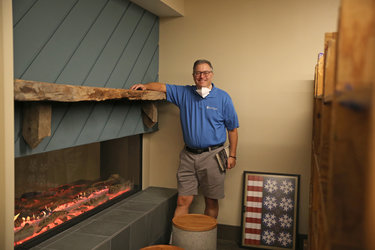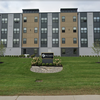Guilderland library puts $4.2 M budget up for vote
GUILDERLAND — On May 17, Guilderland school district residents will vote on a $4.2 million public library budget.
The $4,174,465 spending proposal is up $77,365 from the current year.
The lion’s share of the budget — close to $3 million — is for salaries and benefits; this is $80,500 less than the current year because of a reduction in the state’s retirement system billing.
“This was a pleasant surprise when this number came in this year,” said the library’s director, Timothy Wiles.
He credited the reduction to the system’s investments and its calculations on retirees statewide receiving payments as well as the profile of Guilderland’s library staff.
The library has 65 employees, 40 of whom work full-time. There has been no change in staffing levels from the previous year. Also, there have been no salary increases.
“One of our promises to the public with the renovation was that we would not add any positions,” said Wiles.
He estimated that the building project, which upgraded and expanded the library, is more than 98 percent complete. And, although final numbers won’t be available until the project closes, the library is on target to come in under budget by about $250,000, Wiles said.
The $8.8 million project broke ground in October 2020, after the public passed a bond referendum for close to $7 million. The library contributed $1.4 million from its fund balance and another $760,000 is expected from state funds.
The project went to bid just as the pandemic started, Wiles recalled. Since the project was under the jurisdiction of the State Education Department, it was considered “essential” and could proceed despite the shutdown meant to stem the spread of the coronavirus.
“There was negative competition among major contractors, general contractors, and that helped us a lot …,” said Wiles. “As soon as we bid the contract, we also ordered probably 90 or 95 percent of the material that we would need to do the renovation. So it was by and large all ordered before the supply chain became an issue for anyone.”
While prices of wood, for example, spiked later in the pandemic, at the time Guilderland bought its supplies, wood prices were depressed, Wiles said.
The architect, who has been designing libraries for 15 years, said she never had one come in under budget,” said Wiles. “We lucked out,” he said.
He added, “While I try to manage resources carefully, I can’t take credit for global laws of supply and demand.”
Next year’s budget shows a decrease of $46,000 — from $108,000 this year to $62,000 next year — in building and equipment maintenance costs because of major expenses covered in renovation.
This decrease in spending more than makes up for increases caused by the capital project: Utilities are to go up $5,000 and insurance costs are to go up $14,000.
The insurance costs are expected to increase from $18,800 this year to $32,800 next year for several reasons. There is more square footage to insure and also the replacement costs hadn’t been updated in many years, Wiles said
Finally, he said, in the past, the school district insured the library building while the library insured the building’s contents. Next year, however, the library will be insuring both the building and its contents.
Calling it “a prudent decision,” Wiles said taxpayers would be paying the same overall — what they paid to the school district this year, they will instead pay to the library next year.
Revenues
The bulk of the budget — $4,164,265 — will be covered through the tax levy. This is $109,265 more than the current year’s levy.
While the revenue from interest is up slightly — from $2,900 this year to $3,000 next year — the funds raised from fees and gifts are down.
Overall, these non-tax revenues will decline from $42,100 this year to $10,200 next year.
This year, the library received $20,700 in fines for overdue materials. Next year it expects to get just $3,200 from patrons who haven’t returned materials at all and therefore must pay for the missing items.
This is because the library recently adopted a fine-free policy, following a national trend.
“It shouldn’t be a punitive place …,” Wiles said of the library. “It should be a service place.”
The Guilderland library used to charge 20 cents per day for an overdue book. Before the pandemic, fines for overdue books typically totaled about $30,000 annually, Wiles said. Keeping track of all those transactions was not an efficient use of taxpayer funds, he said. “It probably cost $30,000 to collect them,” Wiles said of the fines.
Further, he posited that it is “kind of a tax cut.” Wiles explained, “It’s $30,000 in money that belongs to the public that isn’t going to come into here this year.”
Similarly, he said that the reduction in revenues — from $4,500 this year to $1,000 next year — from photocopying at the library will help the public.
The cost of making a photocopy is being cut in half. Color copies that cost 50 cents now will cost 25 cents next year, while black-and-white copies will be reduced from 20 cents to 10 cents.
“People might make more copies,” Wiles said, adding that a second copier will be purchased for public use.
Some reacted to a fine-free library by asking, “Who’s going to teach our children to be responsible?” said Wiles. “The answer to that, for me, is teaching your children responsibility is not in the mission statement of the library … it is a parent’s job, not a library’s job.”
The library, he said, is fostering a “kindness economy.”
Wiles explained, “The reason to bring something back on time or even early, if you’re done with it, is because somebody else might want to use it.”
Circulation
The Guilderland library reopened for in-person use on Sept. 28, 2021 after being closed both for COVID and construction.
Use was slow at first, said Wiles, but began to pick up on March 1. While circulation has increased over curbside service, it has not fully rebounded, he said.
Both circulation and library visits have increased on weekends, Wiles said, and the library continues to get “good participation numbers” with its virtual programs.
“Circulation now is 85 percent of where it was pre-pandemic,” said Wiles, and foot traffic is “steadily rising.”
Programming was set to start in April, Wiles said. “In fact, we had a couple of physical in-person programs in April, and then the county entered this latest phase of COVID. And so we decided to put the brakes on programming and meeting room use for now.”
New York State is currently the nation’s hotspot for a resurgence of COVID-19, which is fueled by two new Omicron variants. Both Albany County and the Centers for Disease Control and Prevention have issued guidance for people to wear masks indoors in public.
Three library staff members and three board members serve on a COVID committee that reviews the latest numbers and trends to set library policy on the pandemic.
“While we are very eager to return to in-person programming, our meeting rooms aren’t completely finished yet from the construction process,” said Wiles, citing supply-chain issues.
He also said, “We’re doing what we think is the right thing vis-à-vis the COVID recommendation and basically not promoting indoor gatherings at this point.”
The library is currently asking patrons to wear masks and is giving them away, for free, to anyone who arrives at the library without one.
“There are two approaches on masks,” said Wiles. “You can either require them or make them completely optional. And we decided to try to take a middle course and appeal to people’s judgment and membership in a community and so forth, and say, ‘Please wear a mask.’”


